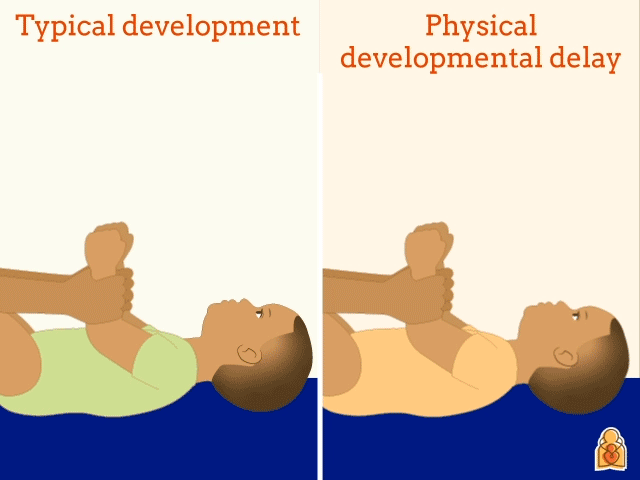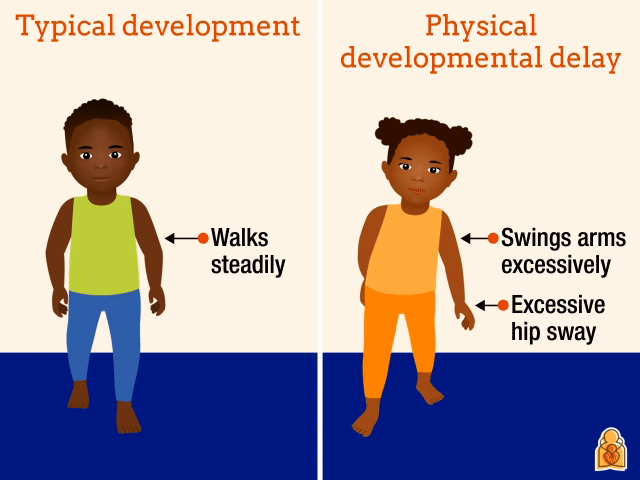Rolling over, sitting, standing and walking—these are some of the typical motor skills that babies and young children develop in the first months and years of life.
Typically, children develop motor skills from the top down. First comes head control and then control over the upper body. While working on these motor milestones, children also develop small, fine motor skills—like using their hands to grasp objects and their fingers pick up small bits of food.
But what if your
baby,
toddler or
preschooler is not meeting typical physical milestones? They may have
physical developmental delays—also known as
gross motor delays.
These delays can be a sign of something more serious. Spotting these signs and finding the health condition as early as possible will help your child get the care they need.
Read on to learn about signs to look for and when to share your concerns with your pediatrician.
Signs of a physical developmental or gross motor delay
 Struggling to roll over, sit or walk Struggling to roll over, sit or walk Difficulty holding head and neck steady Muscles seem stiff or floppy Has a hard time staying balanced or has unusual gait when walking or running
|
Common concerns from parents about delayed physical development
 My child moves or does not move their body like other children their age. My child moves or does not move their body like other children their age. My child moves or does not move their body like other children their age. My child has difficulty doing a skill that other children of the same age can do. My child used to do a skill and can no longer do that skill.
|
Remember: You know your child best. If any of these signs and concerns sound familiar or if you have any other concerns, speak up! Usually, a child who is not doing certain skills will catch up to other children their age. Sometimes, it is a sign of a health condition.
Keep track of motor skills and delays
Knowing when and how to expect your child to be able to do physical developmental milestones can help you spot a motor delay early.
The American Academy of Pediatrics (AAP) created an online tool for parents called Does My Child Have Physical Developmental Delays? This interactive tool is a starting point for caregivers about physical developmental delays in babies and children age 2 months to 5 years.
Use the tool to explore skills and create a checklist of concerns to start a conversation with your child's pediatrician.
Note: The Motor Delay Tool only focuses on physical development. To track your child's social, emotional, communication and learning milestones, visit
Learn the Signs. Act Early. Also, keep in mind that if your child was born prematurely (before 37 weeks of pregnancy) they may develop later than other children the same age. See
Preemie Milestones.
Next step: Talk with your pediatrician
When you share your checklist and concerns about your child's development with the pediatrician, they will listen carefully and may ask you some additional questions. You may also be asked to complete screening questionnaire online or on paper; this is an
assessment for developmental delays. Parent observations are an important part of a pediatrician's evaluation. Pediatricians use parental input on these questionnaires as a basis for further examination and referral. See these
tips from the CDC for talking with your child's pediatrician about development.
Common therapy for physical developmental delays
If a motor delay is found,
early intervention services and resources are available to support and enhance your child's development. For example:
A child with delayed gross motor skills like rolling over, sitting or walking may be referred to a physical therapist.
A child who has trouble understanding language, using language or swallowing may be seen by a
speech/language therapy.
A child struggling with fine motor skills, visual motor skills or independent skills—feeding themself, picking up small objects or buttoning clothes—may benefit from
occupational therapy.
Support for families after diagnosis
Your pediatrician can help you connect with support groups and resources in your community. These and other support groups are here to help guide families through the next steps:
More information